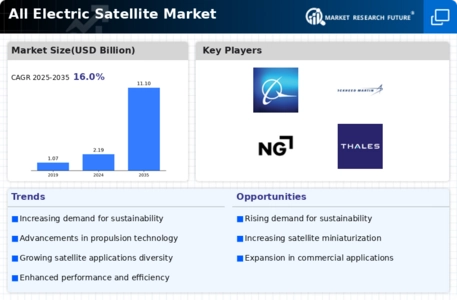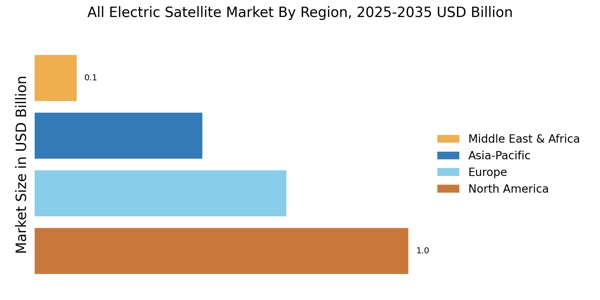Cost Efficiency and Operational Savings
Cost efficiency is a primary driver in the All Electric Satellite Market, as electric propulsion systems offer substantial operational savings. These systems require less fuel and maintenance compared to traditional propulsion methods, leading to lower overall mission costs. As satellite operators seek to maximize their return on investment, the shift towards all electric satellites becomes increasingly appealing. In 2025, it is projected that operational costs for electric satellites will be reduced by up to 30% compared to their chemical counterparts. This financial incentive is likely to encourage more companies to invest in all electric technologies, further propelling the growth of the All Electric Satellite Market.
Increased Investment in Space Exploration
Investment in space exploration is witnessing a notable increase, which is positively impacting the All Electric Satellite Market. Governments and private entities are allocating significant resources towards space missions that require advanced satellite technologies. The trend towards all electric satellites aligns with the goals of many space agencies to enhance mission capabilities while minimizing environmental impact. By 2025, it is anticipated that funding for satellite technology development will exceed 10 billion USD, with a considerable portion directed towards electric propulsion systems. This influx of investment is likely to foster innovation and drive the expansion of the All Electric Satellite Market.
Rising Demand for Communication Satellites
The demand for communication satellites is on the rise, significantly influencing the All Electric Satellite Market. With the increasing need for high-speed internet and connectivity, especially in remote areas, electric satellites are becoming a preferred choice due to their efficiency and operational longevity. As of 2025, the market for communication satellites is expected to reach a valuation of over 20 billion USD, with a substantial portion attributed to all electric models. These satellites offer enhanced bandwidth and lower operational costs, making them attractive to service providers. This growing demand is a crucial driver for innovation and investment in the All Electric Satellite Market.
Technological Advancements in Satellite Design
The All Electric Satellite Market is experiencing a surge in technological advancements that enhance satellite design and functionality. Innovations in materials and engineering techniques have led to lighter and more efficient satellites. For instance, the integration of advanced solar panels and electric propulsion systems has improved energy efficiency, allowing satellites to operate longer and with reduced fuel consumption. As of 2025, the market is projected to grow at a compound annual growth rate of approximately 15%, driven by these advancements. The ability to deploy smaller, more capable satellites is reshaping the landscape of satellite communications and Earth observation, making it a pivotal factor in the All Electric Satellite Market.
Regulatory Support for Sustainable Technologies
Regulatory frameworks are increasingly favoring sustainable technologies, which significantly impacts the All Electric Satellite Market. Governments and international organizations are implementing policies that promote the use of electric propulsion systems, which are more environmentally friendly compared to traditional chemical propulsion. This regulatory support is likely to accelerate the adoption of all electric satellites, as manufacturers seek to comply with new standards. In 2025, it is estimated that over 60% of new satellite launches will utilize electric propulsion, reflecting a shift towards sustainability. This trend not only aligns with The All Electric Satellite Industry.


















Leave a Comment